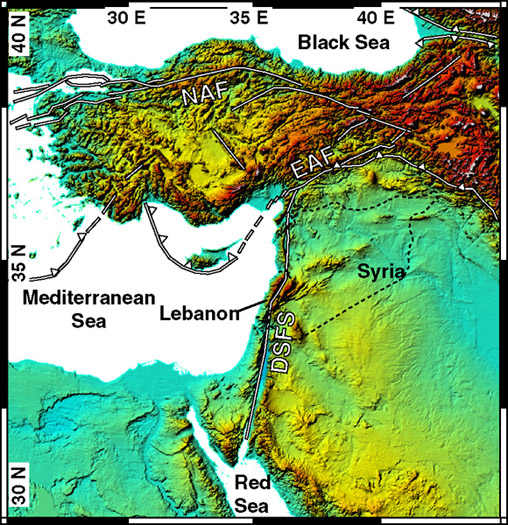Regional Tectonic Background
 The eastern
Mediterranean region is dominated by the collision of the Arabian and African
plates with Eurasia, and within this tectonic framework, the left-lateral Dead
Sea Fault System (DSFS) forms an ~1,000 km long continental transform
fault extending from the Red Sea spreading center northward to the collisional
zone in southern Turkey. Within Lebanon and southwestern Syria, the DSFS
enters a ~200 km long restraining bend in which the simple trace of the southern
DSFS (between Jordan, Palestine, and Israel) develops into several prominent
splays including the Yammouneh, Serghaya, and Roum faults. Near the northern
border of Lebanon, the DSFS emerges from the bend and can be traced as the relatively
simple Ghab fault segment.
The eastern
Mediterranean region is dominated by the collision of the Arabian and African
plates with Eurasia, and within this tectonic framework, the left-lateral Dead
Sea Fault System (DSFS) forms an ~1,000 km long continental transform
fault extending from the Red Sea spreading center northward to the collisional
zone in southern Turkey. Within Lebanon and southwestern Syria, the DSFS
enters a ~200 km long restraining bend in which the simple trace of the southern
DSFS (between Jordan, Palestine, and Israel) develops into several prominent
splays including the Yammouneh, Serghaya, and Roum faults. Near the northern
border of Lebanon, the DSFS emerges from the bend and can be traced as the relatively
simple Ghab fault segment.
Present-day plate tectonic models predict that the relative motion between
Arabia and Africa is about 5 - 10 mm/yr, and these predictions are consistent
with results from field studies along the southern DSFS (e.g., Garfunkel
et al., 1981; Galli, 1999; Klinger et al., 2000a). Preliminary
results from GPS stations straddling the southern DSFS and the northernmost
DSFS in Turkey are also consistent with this range, although associated
confidence limits are broad and velocities may reflect local effects of
elastic strain accumulation (e.g., McClusky et al., 2000).
Although a paucity of instrumentally recorded seismicity (approximately
1900 to present) along the central and northern SFS (Figure 2a) has in
part led to suggestions that the northern DSFS is inactive and that the
locus of present-day deformation is offshore to the west (e.g., Butler
et al., 1997, 1998; Girdler, 1990), field observations and historical seismicity
suggest active faulting of the northern DSFS.
Historical records of large, devastating earthquakes also attest to
the activity and seismogenic potential of the central and northern
DSFS (Figure 2b), despite the scarcity of moderate and large events in
instrumental records (Figure 2). One of the best documented and most
recent events (M = 7.4) occurred in 1759 affecting the Bekaa Valley of
Lebanon (Figure 4) along a rupture of at least 100 km in length (Ambraseys
& Barazangi, 1989). Other significant earthquakes occurred in
551, 1157, 1170, 1202, 1408, and 1837 (e.g., Mouty et al., 1998;
Ambraseys & Jackson, 1998). Although surface ruptures relating
to most of these events have not been confirmed with field observations,
the macroseismic information demonstrates that the effects of these events
were most intense along the trace of the DSFS.
In addition to the DSFS, late Cenozoic deformation has occurred within the
adjacent region of the Arabian plate in the Palmyride fold belt, the Jebel Abdel
Aziz of northeastern Syria, and the Euphrates fault system . Whether or
not these internal deformations of the northern Arabian plate continue today
is unresolved, although seismicity in the Palmyride fold belt (e.g., Mw 5.1
in 1996) suggests this as a possibility.
Return
to Dead Sea Project Home
For
questions or comments, please contact Muawia Barazangi: mb44@cornell.edu.
Last
updated: August 2006
 The eastern
Mediterranean region is dominated by the collision of the Arabian and African
plates with Eurasia, and within this tectonic framework, the left-lateral Dead
Sea Fault System (DSFS) forms an ~1,000 km long continental transform
fault extending from the Red Sea spreading center northward to the collisional
zone in southern Turkey. Within Lebanon and southwestern Syria, the DSFS
enters a ~200 km long restraining bend in which the simple trace of the southern
DSFS (between Jordan, Palestine, and Israel) develops into several prominent
splays including the Yammouneh, Serghaya, and Roum faults. Near the northern
border of Lebanon, the DSFS emerges from the bend and can be traced as the relatively
simple Ghab fault segment.
The eastern
Mediterranean region is dominated by the collision of the Arabian and African
plates with Eurasia, and within this tectonic framework, the left-lateral Dead
Sea Fault System (DSFS) forms an ~1,000 km long continental transform
fault extending from the Red Sea spreading center northward to the collisional
zone in southern Turkey. Within Lebanon and southwestern Syria, the DSFS
enters a ~200 km long restraining bend in which the simple trace of the southern
DSFS (between Jordan, Palestine, and Israel) develops into several prominent
splays including the Yammouneh, Serghaya, and Roum faults. Near the northern
border of Lebanon, the DSFS emerges from the bend and can be traced as the relatively
simple Ghab fault segment.